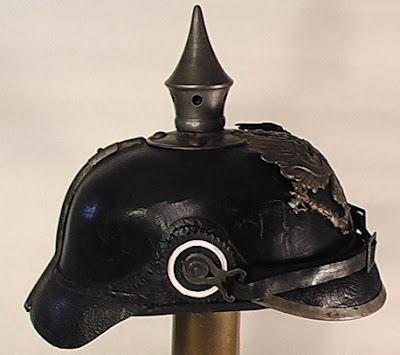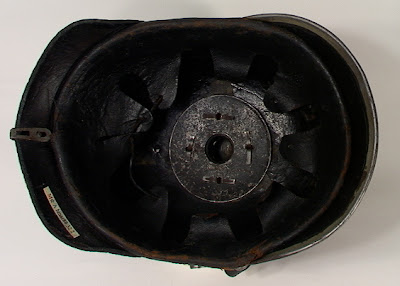 Leave it to those rootin' tootin' teutons to provide the world with what is, arguably, the most distinctive helmet design of the late 19th and early 20th century; the pickelhaube, or, "spiked helmet"
Leave it to those rootin' tootin' teutons to provide the world with what is, arguably, the most distinctive helmet design of the late 19th and early 20th century; the pickelhaube, or, "spiked helmet"I picked up this one in 1978 in Lansing Michigan. At that time I was attending Michigan State University. Back then there were a couple of junk stores-cum-antique shops on Michigan avenue about eight or ten blocks from the magnificent capitol building. This district was home to all of the restaurants, watering holes, and gay bars that catered to a diverse clientele of legislators, winos, leather guys, and helmet weenies, I being of the latter persuasion.
I was living off my GI bill money so I didn't have a lot of cash to spread around, but when I spotted this helmet in an old warehouse of a junk store, I knew that I had to take it home with me. It was surprisingly complete and in pretty good considering it had been sitting around for who-knows- how- long in a junk store.
Today I probably couldn't afford a comparable helmet at current prices.
The spiked helmet of WWI is a classic, even a cliché. It is the caricature of prussian militarism.
 And of course, who can forget...
And of course, who can forget...
I think its fair to trace the roots of this style back to the Indo Persian helmet.
The tight fitting dome and very fierce spike are referenced by the, less combat functional, Pickelhaube of 1915.
This very cool example is circa 1700. Check the garage, you never know what might be under that stack of old fruit crates.
 Front view with eagle front plate ("wappen") and sliding buckle chin strap.
Front view with eagle front plate ("wappen") and sliding buckle chin strap. Left view showing the red, white, and black Reichs kokarde (relax, lets just say "cockade").
Left view showing the red, white, and black Reichs kokarde (relax, lets just say "cockade"). Left side showing the other ranks (enlisted men's) black and white state kokarde, in this case the state is Prussia. Note that the Kokarden on this helmet are reproductions, the rest of the helmet is, as near as I can determine, completely original.
Left side showing the other ranks (enlisted men's) black and white state kokarde, in this case the state is Prussia. Note that the Kokarden on this helmet are reproductions, the rest of the helmet is, as near as I can determine, completely original. The back of the helmet showing the rear visor and the reenforcing spine. But wait, there's more!
The back of the helmet showing the rear visor and the reenforcing spine. But wait, there's more!  The spine is hollow, and note the little metal sliding door that provides an adjustable opening. What's up?
The spine is hollow, and note the little metal sliding door that provides an adjustable opening. What's up? The interior view shows the intact liner and upon closer inspection one of the greatest mysteries of this helmet is slowly revealed...
The interior view shows the intact liner and upon closer inspection one of the greatest mysteries of this helmet is slowly revealed..."Why the spike?"
When I take this helmet around to school groups, I'll always ask the kids what the spike is for. Invariably, they give the same answer. A fourth grader will bend over and lunge forward in a pantomime of the pointy part's perceived purpose, that is, to charge the enemy soldier and stab him (or at least freak him out) with the deadly spike. After congratulating the kid on a fine and reasonable guess I then reveal the very mundane point of , er, the point.
 Peer into the bowl of the helmet...hey! I see daylight!
Peer into the bowl of the helmet...hey! I see daylight!Note the holes emitting light (and air) around what is the base of the spike. Also, notice the small hole to the left of that base, it connects with the spine.
 Back to the outside of the helmet and it all starts to become obvious. The holes are to provide some airflow, ventilation for this helmet. You can imagine just how uncomfortable this tight fitting, black, helmet could be in hot weather.
Back to the outside of the helmet and it all starts to become obvious. The holes are to provide some airflow, ventilation for this helmet. You can imagine just how uncomfortable this tight fitting, black, helmet could be in hot weather.  The screw-off spike now reveals the communicating holes into the bowl of the helmet. The spike itself is merely a decorative and rain proof cupola.
The screw-off spike now reveals the communicating holes into the bowl of the helmet. The spike itself is merely a decorative and rain proof cupola. Moving some air through this headgear may be all that can keep the young WWI German soldier from passing out while standing in formation, under the sun, waiting for Edith Cavell to appear before the firing squad.

Sorry, just an unpleasant reminder to keep it all real.
There you have it, an up close and personal exploration of the M-91 pickelhaube of 1915.
For an absolutely exhaustive, and pretty fantastic study of the pickelhaube, go to:
http://www.kaisersbunker.com (in my links at right), you'll be glad you did.
See you next time with another cool helmet from the collection.
Mannie


2 comments:
i've been looking for the reason for the spike for ages.
thanks for the answer ;)
Post a Comment